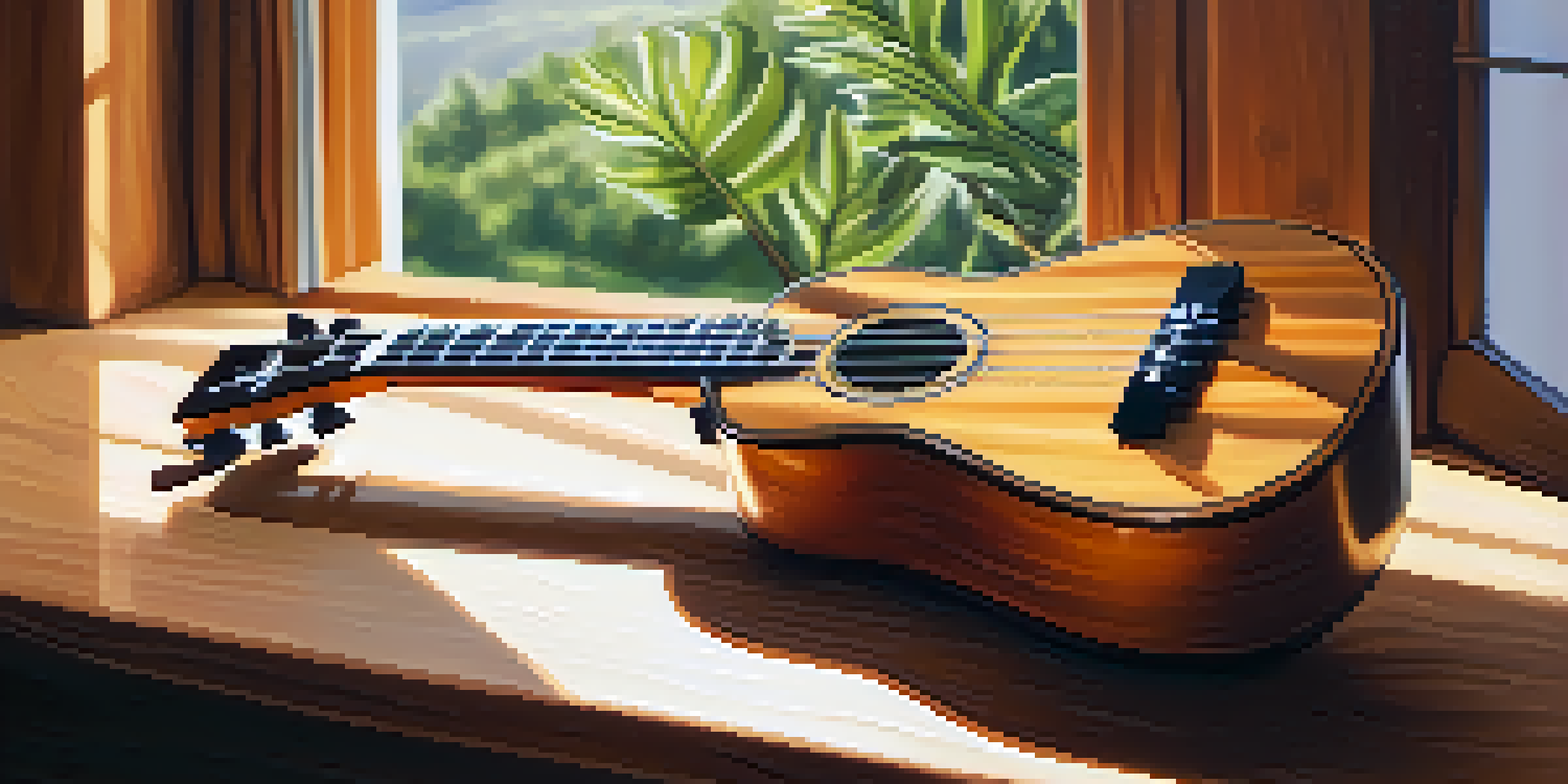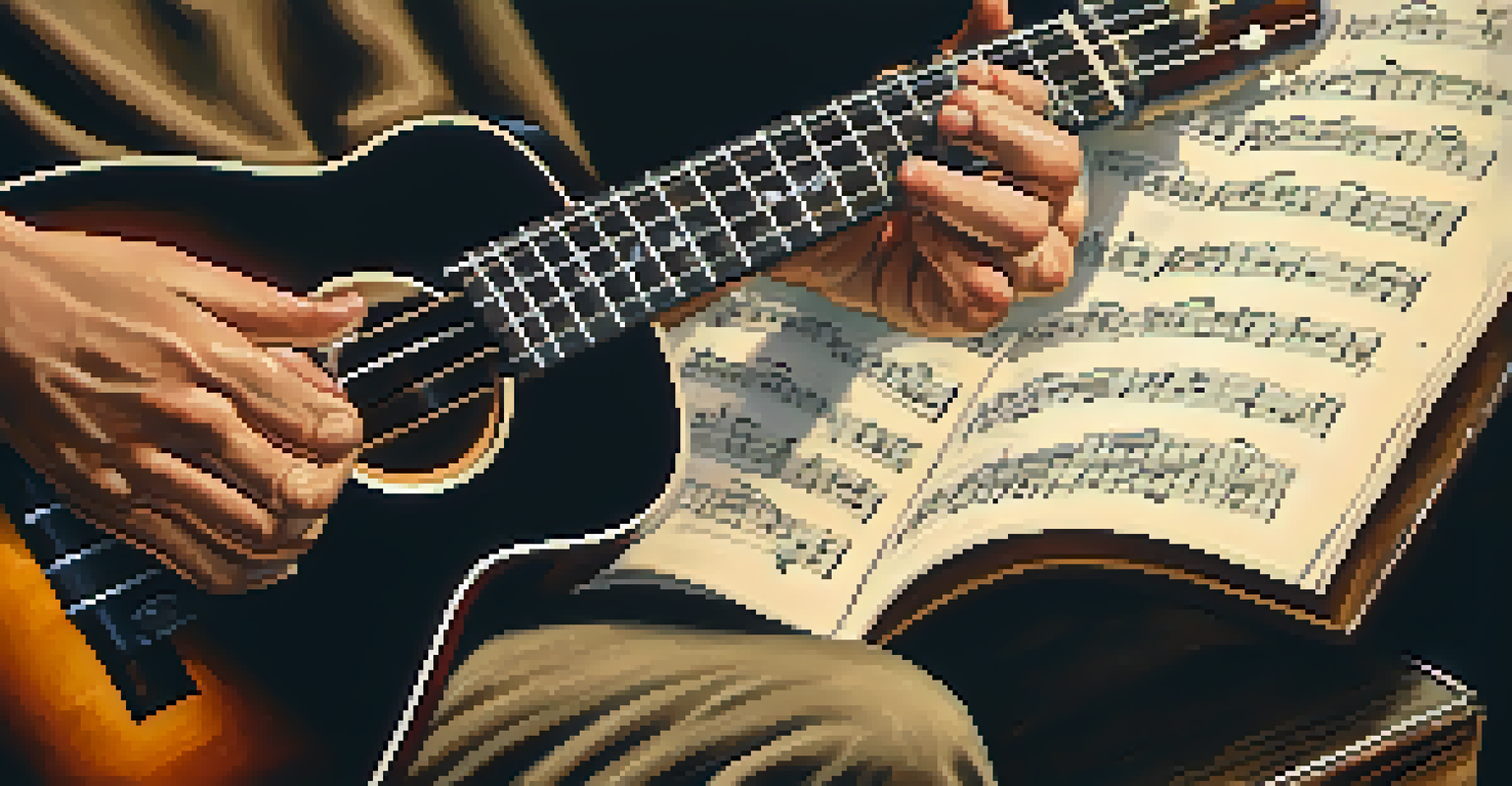Exploring Ukulele Vibrato Techniques for Expressive Playing

Understanding Vibrato: What It Is and Why It Matters
Vibrato is a technique that adds a rich, expressive quality to your playing, similar to a singer's slight pitch variation. It can transform a simple note into something deeply emotional, drawing listeners in. As with any musical expression, mastering vibrato on the ukulele can take your performance to another level, making it feel alive and dynamic.
Music is the shorthand of emotion.
Think of vibrato as a spice in cooking; just like a pinch can enhance a dish, vibrato can elevate a note. It helps to convey feelings and nuances that a straight note might miss, allowing you to connect with your audience on a deeper level. This expressive technique can be particularly powerful in solo performances, where every note counts.
In this article, we will delve into various vibrato techniques tailored for the ukulele, ensuring you have the tools to make your music resonate. Whether you're a beginner or more experienced player, understanding vibrato will enhance your musical vocabulary and overall performance.
Basic Finger Vibrato: The Foundation of Expression
Finger vibrato is one of the simplest and most effective ways to introduce vibrato into your playing. It involves subtly bending the string with your fretting hand while sustaining a note, creating a wavering sound that can be both haunting and beautiful. This technique can be used on any note, adding a personal flair to your music.

To practice this, start by playing a note and gently rocking your finger back and forth. The key is to keep it subtle; too much movement can produce an unintentional sound. Imagine gently shaking a tree branch to create a soft rustle; that's the kind of gentle motion you want to achieve with your finger vibrato.
Vibrato Enhances Musical Expression
Vibrato adds emotional depth to notes, transforming simple melodies into captivating performances.
As you become more comfortable, experiment with different speeds and intensities. This will not only help you find your unique vibrato style but also allow you to express a range of emotions through your playing, making your performances more engaging.
Using Arm Vibrato for Greater Depth and Range
While finger vibrato is effective, arm vibrato can add another layer of depth to your sound. This technique involves using your arm to create a rocking motion, which can produce a more dramatic effect. It’s particularly useful when playing sustained notes, as it allows for a wider range of expression.
The beautiful thing about learning is that no one can take it away from you.
To practice arm vibrato, hold the ukulele firmly and use your forearm to pivot slightly while your fingers press down on the strings. Picture a pendulum swinging; this motion will create a smooth, fluid sound that resonates beautifully. The larger motion can produce a stronger vibrato than finger movement alone.
Incorporating arm vibrato into your playing can elevate your style, especially in solos. As you gain confidence, try mixing both finger and arm vibrato for a more complex sound, making your performances uniquely yours.
Exploring the Slide Technique for Enhanced Vibrato
Slide vibrato involves gliding your finger along the string while playing a note, creating a smooth transition between pitches. This technique can be particularly expressive, allowing you to convey feelings of yearning or nostalgia in your music. It’s a technique often used in blues and folk music, making it a great addition to your repertoire.
To practice slide vibrato, choose a note and slide up or down the fretboard while maintaining pressure on the string. Imagine a bird gliding effortlessly through the sky; this is the kind of fluid motion you want to emulate. The challenge lies in controlling the slide to ensure it feels natural and not forced.
Master Various Vibrato Techniques
Practicing finger, arm, and slide vibrato techniques allows musicians to convey a wide range of emotions.
As you become proficient, experiment with different frets and sliding speeds to see how they affect the sound. This technique opens up a world of possibilities for creating emotional depth in your playing, making your music even more compelling.
Combining Vibrato Techniques for Unique Soundscapes
Once you’ve practiced various vibrato techniques, it’s time to get creative by combining them. Mixing finger, arm, and slide vibrato can produce a rich tapestry of sound that captivates listeners. Just like a painter layers colors to create depth, you can layer vibrato techniques to add complexity to your music.
Start by selecting a passage in a song where you want to add vibrato. Experiment with using finger vibrato on some notes and transitioning to arm vibrato on others. Imagine a conversation between two friends, where each voice has its distinct tone; this blending creates a more dynamic and engaging performance.
The key is to remain aware of the overall sound you’re creating. Listen intently to how these techniques interact and adjust accordingly. By finding your unique combination, you’ll be able to express a wide range of emotions, enhancing not just your playing, but the overall listening experience.
Practical Tips for Developing Your Vibrato Skills
Like any skill, developing vibrato takes practice and patience. Start slow; it’s better to master a subtle, controlled vibrato than to rush into more complex techniques. Use a metronome to keep your timing steady, which is crucial for creating a consistent sound. Remember, consistency is key in music.
Consider recording yourself while practicing. Listening back can provide valuable insights into areas that need improvement, helping you refine your technique. It’s similar to looking in a mirror; you can see your progress and identify what works and what doesn’t.
Incorporate Vibrato into Your Style
Integrating vibrato into your playing can personalize your music and strengthen your connection with the audience.
Additionally, don’t hesitate to seek feedback from fellow musicians or instructors. They can offer tips and perspectives that you might not have considered. Embrace the journey of learning vibrato, and remember that every note you play is an opportunity to express yourself.
Incorporating Vibrato into Your Musical Style
Now that you have a solid understanding of vibrato techniques, the next step is to incorporate them into your musical style. Think about the genres you enjoy playing and how vibrato can enhance your expression within those styles. Whether it’s folk, pop, or jazz, vibrato can add a personal touch to any piece.
Start by selecting a few songs that resonate with you and identify where vibrato can be effectively applied. For instance, in a heartfelt ballad, using a gentle finger vibrato can evoke deep emotions. It’s all about finding the right moments to infuse your playing with this expressive technique.

As you experiment, allow your personality to shine through. Your unique interpretation of vibrato will make your performances memorable. Remember, music is about connection—both with your instrument and your audience—and your vibrato can be the bridge that brings everyone together.